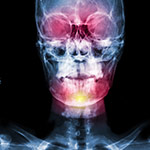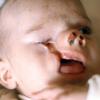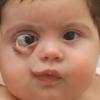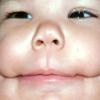WHAT ARE CRANIOFACIAL CLEFTS
The craniofacial clefts are large clefts which may affect the face, the cranium or both of them. It is rarer than the simple cleft lip and palate and are presented sporadically without following any rules of inheritance. Their severity varies significantly from one smallest notch in the lip or nose or a "scar" on the cheek up to a dramatic separation of the tissues of a part of the face.
FREQUENCY
Although craniofacial clefts are rare, their real incidence is quite difficult to be estimated, because the milder types can escape diagnosis.
CLASSIFICATION
The craniofacial clefts follow certain facial axes whose course has been numbered for classification and filing purposes. The reference point is the orbit and the numbers follow a counter-clockwise so that the smaller numbers to have a ‘south’ direction and concerning face, while the larger numbers have a "north" direction and concerning mainly the cranium.
More than one craniofacial cleft can coexist and then the clinical image is correspondingly more severe. Different areas of the face are influenced depending on the cleft. For example, the cleft 0 (meaning craniofacial dysraphia or dysraphism) causes widening of the ridge of the nose, while the clefts number 1 and 2 affect the lateral aspect of the nose. The cleft number 3 separates the nose from the side and usually affects the spear and the eye in the homonymous side. The cleft number 4 can also mean absence of the eye and orbital deformity in the homonymous side. The cleft numeral 5 is rare and affects the upper jaw and the lip. The clefts number 6, 7 and 8 affect the area of the cheekbone and cause deformities of the lateral part of the face and oral angle as well as the lower eyelid. The clefts 11 to 14 affect the area of the forehead and may even cause a tongueline projection from a deficit at the medial third of the frontal hairline.
SURGICAL REHABILITATION
The craniofacial clefts' repair require complex surgeries with the cooperation of several specialties and according to a predetermined schedule. Generally, the surgical rehabilitation begins in infancy and may be lengthened up to adolescence. The careful planning of the necessary surgeries will ensure the best possible results.








